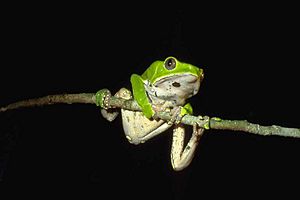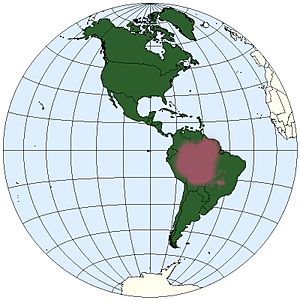Giant leaf frog facts for kids
Quick facts for kids Giant leaf frog |
|
|---|---|
 |
|
| Conservation status | |
| Scientific classification | |
| Genus: |
Phyllomedusa
|
| Species: |
bicolor
|
 |
|
| Synonyms | |
|
|
The giant leaf frog (scientific name: Phyllomedusa bicolor) is also known by other names like the bicolor tree-frog or giant monkey frog. This amazing frog lives in the Amazon basin of South America. You can find it in countries like Brazil, Colombia, Bolivia, and Peru. It also lives in parts of Venezuela and the Guianas.
Contents
About the Giant Leaf Frog
Giant leaf frogs are quite large! Male frogs are about 9 to 10 centimeters long. Female frogs are even bigger, measuring about 11 to 12 centimeters.
Their backs are a bright lime green color. Their bellies are white, yellow-white, or cream. They have small white spots with dark edges on their lower lips, chest, and front legs. These spots are more common on their sides and back legs. Their fingers are a see-through brown, and they have big, green sticky pads on their toes. These pads help them climb trees.
Behind each eye, they have a noticeable gland that extends over their eardrum area. Their eyes have a dark gray center.
Where They Live
Giant leaf frogs live all over the Amazon Rainforest. This includes northern Bolivia, western and northern Brazil, southeastern Colombia, eastern Peru, and parts of Venezuela and the Guianas.
Sometimes, they are also found in the riparian forest areas of the Cerrado. The Cerrado is a huge tropical grassland in Brazil. They prefer tropical humid forests, especially areas near water.
Life and Habits
The giant leaf frog is a nocturnal animal, meaning it is active at night. It is also an arboreal frog, which means it lives mostly in trees.
Male frogs call from trees in the forest to attract mates. During mating season, male frogs might fight each other. They use their heads to try and separate another male from a female. They also make loud, aggressive calls and use their back legs to push rivals away. These fights can be noisy, which might attract predators.
To protect themselves, giant leaf frogs produce special chemicals in their skin. These chemicals act as a defense against predators.
Reproduction and Life Cycle
Giant leaf frogs reproduce like most frogs. The male climbs onto the female's back to fertilize the eggs. This is called amplexus.
The male and female work together to build a nest out of leaves. They build this nest above forest pools, usually about 70 centimeters above the water. The female lays her eggs in a jelly-like mass inside this leaf nest.
The eggs hatch in about 14 days. The tiny tadpoles then fall from the nest into the water below. They continue to grow and develop into adult frogs in the water. Most reproduction happens during the rainy season.
Sadly, many giant leaf frog eggs are eaten by other animals. Up to 61% of their eggs can be lost to predators. Animals that eat the eggs include certain beetles, flies, and even mammals like capuchin monkeys. Snakes also prey on the eggs. The eggs are a good source of protein for these predators.
Conservation Status
The IUCN (International Union for Conservation of Nature) keeps a list of endangered species. They have listed the giant leaf frog in the "Least Concern" category. This means their population is large and spread out, so they are not currently at risk of disappearing.
Traditional Uses
The giant leaf frog produces a special substance on its skin. This substance has been used in traditional practices by some groups. However, there is no scientific proof that it is an effective medical treatment for any condition.
See also
 In Spanish: Rana mono gigante para niños
In Spanish: Rana mono gigante para niños
Images for kids



